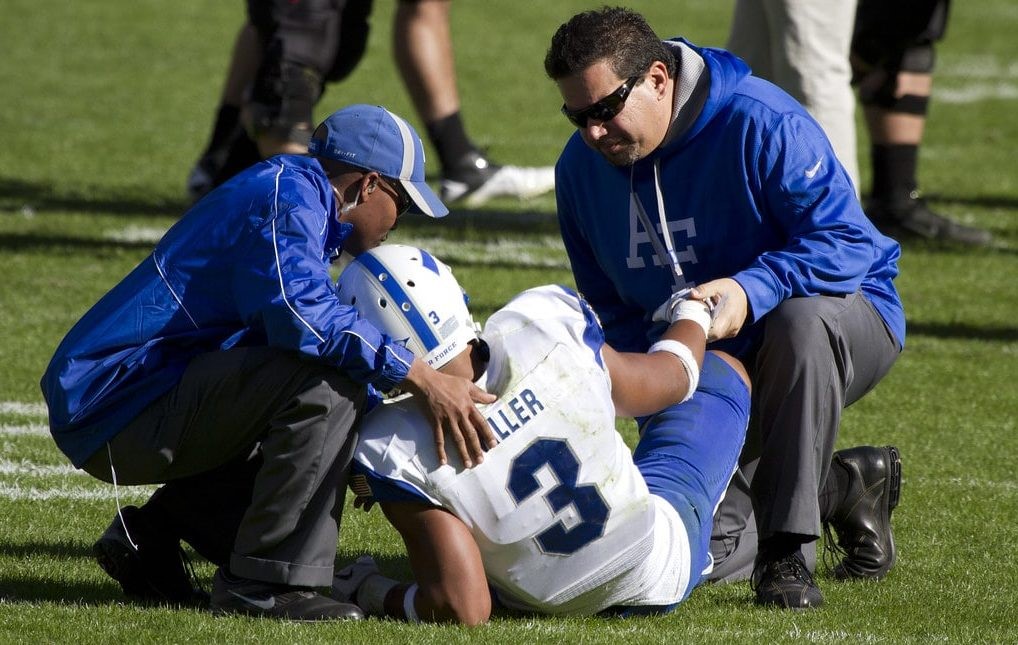“When you can’t control what’s happening, challenge yourself to control the way you respond to what’s happening. That’s where your power is” – Anonymous. It’s not uncommon to find injured athletes. We see them on television being hauled away by medical staff, we see it when people go through long, strenuous hours of physical therapy in order to recover from injuries sustained from their sport. It is impossible to know when you may get hurt while playing, injuries can happen so quickly you may not even notice you got hurt until later on. But when faced with pain, you can control how you respond to it. You can choose to heal and come back stronger and a better player overall. Or you can choose to put yourself in a position where you keep playing and therefore cause more harm. Many student athletes tend to choose the latter, deciding it would be better overall to disregard their health issues and put their sport before their wellbeing. But why? Why do people deliberately choose to ignore their suffering and play through their pain?
Students who play a team sport may face this pressure more than those who play an individual sport. If a student sees a fellow teammate playing through an injury, they often think they, too, should play through an injury. Seventh grader Spencer Hantman stated, “They may feel pressured by teammates to keep playing for the team.”
Coaches can also unintentionally place pressure onto students to keep playing. Athletes who play a higher position on a team can believe that their coaches expect them to be the best no matter what. This can lead to athletes hiding injuries from coaches to continue advancing in their game. Mr. Matthew Varhley, eighth grade U.S. History and Debate teacher, and coach of the boys tennis team at Westfield High School stated, “I don’t allow players to put off injuries because I believe their individual health is more important than their place in the team.”
Furthermore, students may believe that they need to continue playing in order to get a high position on the team, but the opposite result may happen. If an athlete were to play through an injury, their playing could get worse. Research from sports medicine shows that “playing through the pain is almost never a good idea. Here’s why: The strong desire to remain on the field, coupled with elevated endorphin levels from having been in the game, and the surging adrenalin levels that can accompany an injury, mean that the true nature of your pain can be masked — and you won’t be able to accurately assess the extent of your injury.”
Furthermore, numerous athletes play while injured because they don’t want to disappoint them. Bailey Gaines, an eighth grader at EIS, said, “I want to play and not disappoint my team.”
Many people are unaware of the mental pressures that come from many aspects of a team. These pressures are the primary cause of people feeling compelled to play even when they are in immense pain. Some may fear coaches and the impact sitting out has on playing time. Playing high-energy and competitive games, especially at the high school level, is a huge time commitment and a mental commitment that is very demanding and sometimes damaging. In some cases, coaches coach with fear, hoping the players perform better. According to Athletes in Action, “an athlete’s fear of failure does not need to be reinforced with more fear tactics. Instead, helpful coaching and encouragement to get them over this fear so they can play at an optimal level would be much more effective to bring about the results coaches want.” This mentality is actually worse for athletes and may be the reason these sports players decide to worsen their injury by putting it off.
In addition, the physical disadvantages of playing through an injury can lead to major repercussions. Nemours Teen Health says, “Continuing to play if you have an injury can make that injury worse. A small stress fracture that might have healed quickly can grow into a more serious, more painful fracture that will take longer to heal. Returning to play too soon after a concussion increases your risk of serious brain injury.” Injuries as small as a twisted ankle can become something far more severe in a short amount of time. Taking the time to heal is incredibly important for a person. Bodies grow stronger and healthier if they are relaxed and properly treated by a doctor.
In sum, athletes have been under immense pressure for years to show up in any condition and represent their team. Athletes feel as though there is an unspoken rule that they must be there to play for their team. While it is important to support your team and play well, when faced with an injury, choosing to sit out and rest is actually the most beneficial for you and your team. Players tend to see injury as a sign of weakness and betrayal to their team. Deciding to continue pushing forward with an injury results in weakening the body until a person can no longer play properly. This includes differences in playing abilities and loss in concentration due to the excruciating pain. Which harms the team as well. While a small injury may seem insignificant, and watching your teammates play without you may be difficult, taking time to ensure your body is healing guarantees a chance at playing in the future without further harm.










